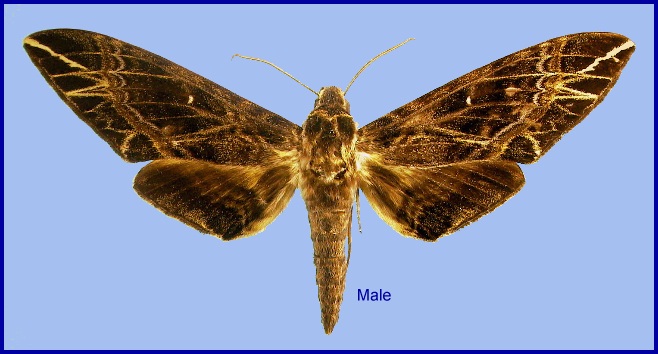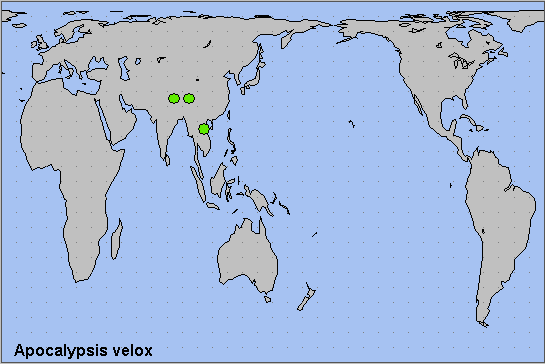
Apocalypsis velox Butler, 1876, Trans. zool. Soc. Lond. 9: 641. Type locality: [India, West Bengal] Darjeeling.
Synonym. Apocalypsis velox devjatkini Zolotuhin & Ryabov, 2012.
Note. Apocalypsis velox devjatkini has been proposed as a subspecies of Apocalypsis velox. The purported diagnostic form of the forewing apical white diagonal line is inconsistent among populations, even among the specimens illustrated by Zolotuhin & Ryabov (2012). The genitalia differences are a little more convincing but need to be checked over a wider range of specimens; they may still be within the range of individual variation for a sphingine. DNA barcodes in BoLD give a distance of 0.62% between the two subspecies, which is very small. Overall, the evidence is not enough (yet) to warrant separate subspecies status for the populations from Yunnan, Laos and Vietnam; it may just be a refugial entity. How far this population extends NW remains to be determined, but samples from Putao in NW Burma barcode as the nominotypical subspecies. The status of the population in Hunan, China, remains to be investigated.
Wingspan: 136mm. Forewing upperside pattern similar to that of the American Euryglottis aper (Walker, 1856). Forewing dark brown; white spots at extremities of veins, which are pale; pale obliquely waved antemedian double lines; a curved postmedian pale band formed of three conjoined lines; a yellow streak from the apex continued as a very dentate line to outer angle. Hindwing dark brown, with traces of lines near anal angle; inner margin yellowish; cilia chequered yellowish and brown. Underside of both wings brown, with median and postmedian indistinct lines. Head dark brown; thorax dark brown, with pale paired lines on each side of vertex; abdomen dark brown, with a series of black dorsal streaks and black segmental lines with white specks on them.
In the male genitalia, uncus long, narrow, pointed, curved ventrad, carinate ventrally. Gnathos long, slightly narrowed towards apex, which is rounded. Valve without a patch of stridulatory scales. Harpe obtusely triangular, not prominent, densely covered with half-erect scales that conceal the harpe's outline. Juxta ending ventrally in a short, rounded lobe. Phallus with a strong, conical apical tooth, shorter than the diameter of the phallus, pointing dextro-laterad and slightly distad. In the female genitalia, ostial plate highly folded anterior to the large ostial cavity; the post-ostial part smooth, more heavily sclerotised than the proximal part.
China: vi (Yunnan); 25.vii.2024 (Yunnan).
OVUM: Pale yellowish-green, slightly oval (2.0 x 2.25mm), smooth and shiny.
In India, the eggs are laid singly on the underside of leaves of Callicarpa arborea Roxb. (Lamiaceae). Eggs and larvae were found on both saplings and large trees, with eggs in June and larvae in July and August (Bell & Scott, 1937).
LARVA: Full-fed about 90mm long. According to Bell & Scott (1937), in the first instar head round; body cylindrical; horn long, straight, tip broadly bifid. Surface of head and body smooth and shiny; the whole hoary, including the bifid tip, set densely with the most minute hairs, each rising from a very small tubercle. Anal flap with a pair of mid-dorsal tubercles. Colour of head and body yellowish-green, horn black. In the second instar, the shape of head and body remain unchanged, but the long, thin, bifid horn rises vertically from a shiny cone, and then bends downward. There are long spine-like tubercles present on all segments of the body; those on 3 to 11 being longer than the rest, with some on 2, 3, 4 and 12 bifid. There are small, scattered, setiform tubercles on the head and horn. Surface of head, body and horn, including the tubercles, smooth. Colour of head pale blue, tubercles paler blue. Body pale orange, with a pale blue rectangular mark above each spiracle and another behind each spiracle on segments 8 to 11. Subdorsal tubercles white, lateral tubercles blue; those on anal flap and claspers black. True legs pale blue; prolegs pale green; horn blue with black tubercles. In the third instar there is very little change, but the colour of the body becomes a deeper orange.
The fourth and fifth instars are very similar. Head semi-elliptical in shape, vertex very broad and flattened. True clypeus one-half length of head; false clypeus absent; ligula kidney-shaped. Surface of head, body, horn and tubercles smooth and shiny. The head is set with small tubercles, with a larger subdorsal tubercle on the front of the vertex of each lobe, with another large tubercle below that. Body nearly cylindrical. Horn long, very thin, bifid, rising vertically from a large cone and bending backwards and slightly downward. Anal flap truncated and the claspers very big and heavy. There is a transverse row of five large rounded tubercles near the front margin of segment 2, and two tubercles and three spines in a transverse row farther back on the same segment. On the front margin of 3 there are a pair of subdorsal spines placed transversely. Behind them there are a longer subdorsal pair and behind these again a still longer pair, with a pair of long double pointed spines below them and three small, spines near base of leg. On the front margin of segment 4 there is a transverse row of four spines, with at about the middle of the segment a transverse row of three long double-pointed spines and on the hind margin a row of small spines, and a pair of short spines near base of leg. On segment 5 there is a long subdorsal spine behind the front margin with a second shorter one behind it, a pair of short spines with their bases confluent in front of the spiracle and a group of five or six small ones below it. There is also a long subspiracular spine. Segment 6 has an extra pair of short spines placed subdorsally in addition to spines as on 5. Segments 7 to 11 have spines as on 5. The thin, slightly tapering, bifid horn rises from a large cone on 12 and this segment has a long spine below and behind the base of the horn. There is another long subdorsal line behind it and a pair of long spines below this. There is also a long spine in front of the spiracle and a pair with confluent bases below and behind it. The uppermost tubercle or spine of each of the transversely-placed pairs, or of each transverse row mentioned above, is subdorsal, and there are, of course, an equal number of tubercles and spines on the other side of the dorsal line. The spines are thick at the base, which is longitudinally oval in section, and taper sharply to a point, the whole spine bending, slightly backward. Anal flap truncate and tumid, with a large pointed tubercle at each lateral angle and a longitudinally-placed pair nearer the base; there are several similar tubercles on the clasper faces.
In colour, head yellowish-green with a broad pale cheek-stripe running from the vertex of each lobe to base of antenna. Body canary-yellow, with a green tinge on segment 2, the anal flap, claspers and venter. The tubercles and spines on 2 to 12 white or blue with white tips; those in the dorsal area have a brown line above and below the base, those in the lateral and spiracular area have the base completely ringed with brown. There are broad oblique lateral stripes starting above the spiracles on 5 to 11 and extending backwards and slightly upwards to the hind margin of each segment. These are blue near the spiracle becoming paler and then white at the hind margin, the whole edged narrowly above and below by brownish purple. Horn, and the cone from which it rises, blue with scattered black tubercles; the tubercles on anal flap and claspers shiny black. Legs and prolegs green. Spiracles elliptical in shape, with a narrow central slit widening at the top and bottom, the whole cream-coloured and ringed with green (Bell & Scott, 1937).
The larva, are sluggish and have no peculiar habits.

PUPA: 57-62mm. Reddish-brown, darker in the dorsal area when fresh; nearly black when old: spiracles black. Slender, with a free tongue-sheath. This is evenly arched and recurved basad, but not into a spiral; the tube rather thin, with a bulbous end. Tongue reaching tip of wing-case; antenna in both sexes slightly longer than fore leg and considerably shorter than mid-leg. Coxal piece absent. Surface smooth and shiny; tongue-sheath coarsely wrinkled with parallel transverse ridges the depressions between the ridges a good deal narrower than the ridges themselves. Head and thorax with the surface broken by shallow uneven cracks. There is no sculpturing on segment 4; segments 5, 6 and 7 sparsely and not very coarsely pitted, the hind margins nearly smooth. Ante-spiracular ridges on 9 in the form of three very narrow ridges separated by wide, smooth, polished furrows, the ridges not extending below the spiracles. Spiracles flat, the central slit bordered by a coarse flattened lip on each side. Cremaster a thin oval or rounded plate, markedly constricted at base, and with two very short blunt teeth at tip; dorsal surface flat, ventral slightly concave, both surfaces coarsely pitted.
The pupa is formed in a cell underground, and is sluggish. Both larva and pupa are very delicate and difficult to rear. There is only one brood in the year and the pupae hibernate (Bell & Scott, 1937).
Larval hostplants. In Yunnan on Clerodendrum trichotomum (Lamiaceae), a common climber used in landscaping (ZhenBang Xu, pers. comm. 2025). On Callicarpa arborea (Lamiaceae) in India (Scott, F. B., 1941).
China: Yunnan (Huanglian Shan, Lüchun, 1900m; Gaojiancao Village; Gaoligong Shan; Laoniuchang, Xinping Yi and Dai Autonomous County [Ji-Shen Wang, iNaturalist 2024]; Qindang, Nujiang Lisu [Ming-Yu Liu, iNaturalist 2024]; Wenshan/Kaihua); Hunan (Dayong).
From Bhutan (Irungbam & Irungbam, 2019), northeastern India (West Bengal, Sikkim, Arunachal Pradesh and Meghalaya) and southwestern China to northern Myanmar/Burma and Vietnam. Also recorded from the Andaman Islands (Chandra & Raghunathan, 2018) and Great Nicobar Island (Singh, Ahmad & Chandra, 2021), but these odd records need confirmation.

 Return to Sphingidae of the Eastern Palaearctic species list
Return to Sphingidae of the Eastern Palaearctic species list